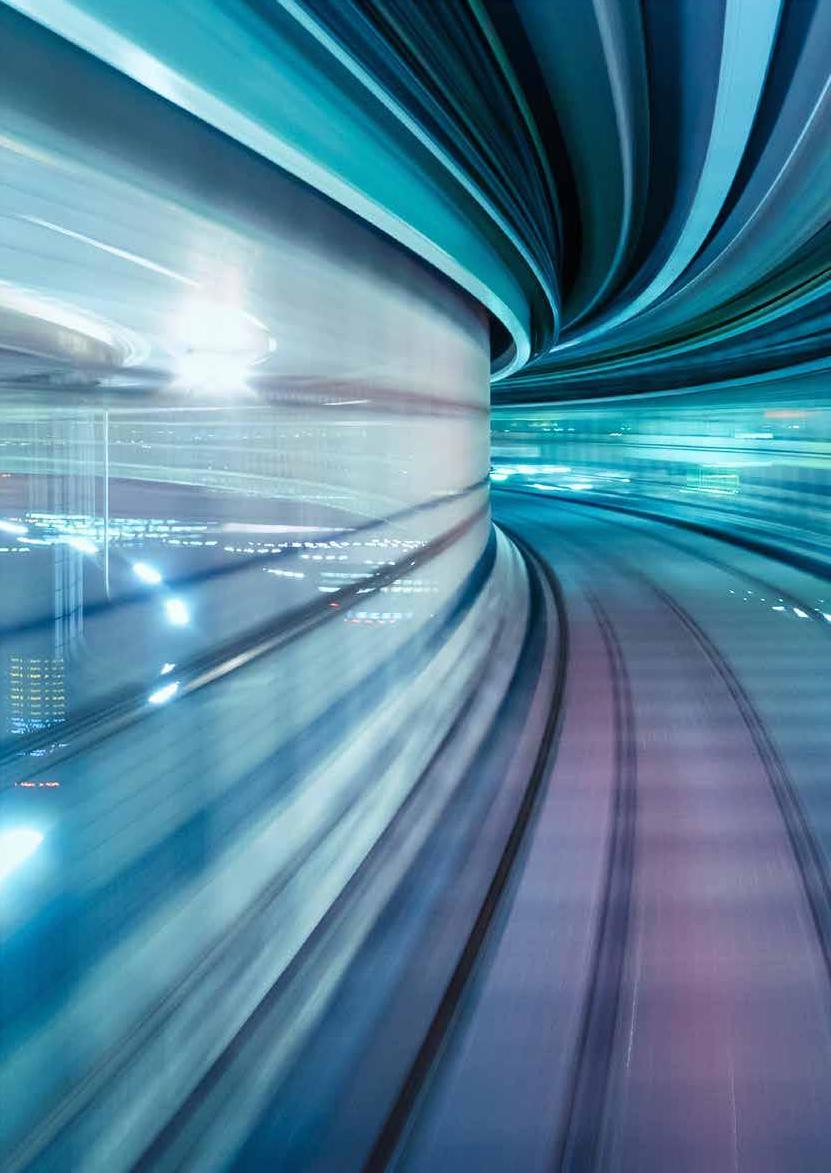
11 minute read
TRANSPORT: Driving the economy, delivering jobs
from AMT OCT/NOV 2021
by AMTIL
TRANSPORT: DRIVING THE ECONOMY AND DELIVERING JOBS
The transport sector is creating big opportunities for manufacturers across Australia. In Perth, Alstom is bringing rail manufacturing back to WA, supported by suppliers such as Hofmann Engineering, while in Brisbane, HC-ATM is assisting Australian and international truck companies through innovative design and know-how. By Carole Goldsmith.
Rail manufacturing has returned to the Midland area in Western Australia, 27 years after the old Midland Railway Workshops closed. World-class railcar manufacturer Alstom is building a fleet of 43 trains for the Public Transport Authority of Western Australia (PTA) at its new METRONET train manufacturing facility in Bellevue, east of Perth. This is part of the $1.3bn, 10-year contract that the WA State Government signed with Alstom in December 2019 to supply 246 new METRONET railcars. Alstom commenced operations at the PTA’s new facility this May. The site’s official opening in June was attended by WA’s Premier Mark McGowan and the Minister for Transport Rita Saffioti. This is an exciting time for new rail manufacturing in WA, and the first of the new trains will be delivered to the PTA next year, much to the delight of all the passengers who will ride these super-smart, innovative new trains. The project will create around 200 new jobs in WA, including for apprentices and Indigenous Australians, to manufacture, test, commission and maintain 41 six-car electrical multiple unit (EMU) trains and two three-car diesel multiple unit (DMU) trains. It also includes 20 years maintenance of the EMU trains and maintenance support services for the DMU trains. Alstom’s Project Director for the METRONET railcar procurement project, Fabrice Ponti explains that Alstom moved into the Bellevue facility in May, and the fit-out will be completed by early October. “The fleet of 43 trains will be built with local suppliers, contractors and equipment vendors,” advises Ponti. “Alstom has committed to 50% local content for the railcars, bringing additional flow-on benefits beyond the delivery of the trains to the WA economy.”
After graduating as a mechanical engineer in France and the US, Ponti’s career has spanned 18 years at Alstom. He has managed a wide range of global roles for Alstom in France, Argentina, Russia and China, before coming to Australia and settling in Perth with his family in 2019, specifically to work on the METRONET rail project. As Alstom did not have its own manufacturing site in WA, Ponti says: “We are in the process of hiring a significant number of employees for the project. We have already sourced 80 local people to work on the site, mainly for production.” As of late August the Alstom team was happy with progress on the fit-out of the new facility, as Ponti explains: “So far, the PTA has provided a manufacturing workshop for the fitting area, which is where we will assemble the railcar and install its components, plus a bogie workshop. The bogie is the rolling undercarriage, essentially composed of a steel frame, axles and suspension systems.” Local supplier Hofmann Engineering will be manufacturing the bogie frames at its Perth manufacturing site from early 2022. Ponti remarks: “Hofmann is a significant supplier as the bogie frames are important parts of the railcar.” He adds: “Soon the PTA will provide a 25,000-volt facility on this same site to enable us to test the train before delivery. The first train is scheduled for completion in the first half of next year. All the 43 trains will be completed by the end of 2029.”


From left: Mark Coxon, Managing Director of Alstom Australia; WA Premier Mark McGowan; and Fabrice Ponti, Alstom Project Director, at the opening of the new METRONET train manufacturing facility in Bellevue, Western Australia. Alstom’s new team of production employees attend a two-to-fourweek internal training program depending on their proposed job. They learn about the company and then are trained on the products and manufacturing processes specific to the project. Trainers use company videos on manufacturing systems and procedures to assist new employee’s learning and skill development. Also, trainees can use virtual reality 3D display technologies to visualise assembling components inside the railcars. “Production employees have iPads, which they use on the job for production processes and to access documentation,” Ponti explains. “As part of our local employment initiative, we are also working with the North Metropolitan TAFE, East Perth, on an apprentice program for Indigenous people. They will serve their apprenticeship on the METRONET project. This will enable them to learn valuable skills on the job, with the view to continue their career with Alstom after they complete their apprenticeship.” Ponti is proud of how the METRONET railcar project is progressing and is very enthusiastic about its future operations: “It’s the return of railway manufacturing to WA after the Midlands railways’ workshops closed in the 90s. Alstom is proud to contribute to this important project for WA.”
Contined next page
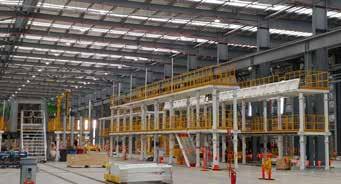
The fitting line being set up at the Bellevue facility.
A visual of the electrical multiple unit (EMU) train that is being manufactured in Bellevue
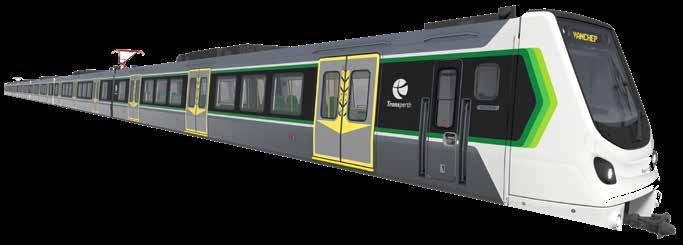
Continued from previous page
Hofmann Engineering – Gearing up for bogie production
As Product Specialist and Operations Engineer at Hofmann Engineering, Karl Hofmann manages the company’s rail portfolio, and he’s looking forward to working on the Alstom METRONET project with his rail team. Hofmann Engineering will commence manufacture of bogie frames for the project’s railcars at its Bassendean manufacturing site in east Perth early next year. “The Transfer of Technology process between Alstom and Hofmann is now being undertaken,” says Karl. “This includes detailed manufacturing plans that needs to be prepared before the bogie production commences. That’s what’s being undertaken at the moment and we have a team of six people working on this phase of the project.” As a global business headquartered in Perth, Hofmann Engineering is well equipped to handle large railcar bogie frame orders. It also manufactures bogies at its Bendigo factory for Public Transport Victoria’s High-Capacity Metro Trains. The first of these passenger trains entered service in Melbourne’s train network in December 2020, and will be rolling stock for the METRO Tunnel when it opens in 2025. Among its other rail projects, Hofmann Engineering also manufactures bogie frames for Downer’s Yarra Trams, in addition to locomotive bogie machining and heat treatment for freight locomotive manufacturer UGL. Explaining about the bogie and its production process, Karl says: “The bogie, which is the steel chassis of the railcar, measures approximately 4m x 3m and is half a metre tall. It’s a fabricated bogie design made primarily from plate material, cut into shapes using a plate cutting machine before being welded using a state-of-the-art welding robot. Following this, a five-axis gantry milling machine will be used for final machining and inspection of the bogie frame. “The manufacturing process is fully integrated in our enterprise resource planning (ERP) system that implements all of the necessary manufacturing controls to ensure that the bogie has been manufactured correctly. From start to finish, it will take the rail production team approximately three months to make a batch of 12 bogies (one trainset).” Hofmann Engineering is one of Australia’s greatest business success stories. Two brothers from Germany, John (Karl’s grandfather) and Erich set up a small toolmaking shop in a Perth backyard in 1969, thinking that there would be a future in gears. It’s come a long way since then, and is now one of the largest gear-making operations in the Southern Hemisphere. Today John’s son, also named Erich, is at the helm as Managing Director, and the company has close to 600 employees, including 350 at its Perth headquarters. The rest of the workforce are located across four manufacturing sites across Australia, its three international manufacturing sites in Chile, Peru and Canada, and at its offices in USA, India and China. Engineering certainly runs in the Hofmann family. Soon after graduating as a mechanical engineer in 2016, Karl spent six months as an engineering intern at five different companies in Germany. He says that the knowledge and experience of German advanced manufacturing he gained was invaluable for his subsequent career at Hofmann Engineering, which he commenced after returning to Australia.
Hofmann Engineering’s head office and manufacturing site in Bassendean, Western Australia. A gantry milling machine at the Bendigo facility, where it manufactures bogies for Public Transport Victoria’s High-Capacity Metro Trains.
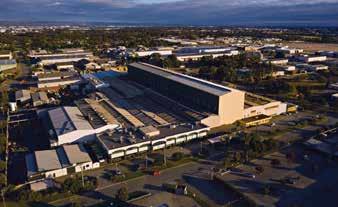


Karl Hofmann, Product Specialist and Operations Engineer at Hofmann Engineering, and Erich Hoffman, the company’s Managing Director.
Regarding the future plans for the family-owned company, Karl says: “We are doing a lot more work in the mineral processing, defence, aerospace, rail and renewable energy sectors. We want to continue growing the business, and are currently extending the Perth factory to cope with the current and anticipated demands. All the company’s profits are put back into the business, with many of the family members working here. In the next 10 years, the target is to work hard to increase the current $170m business value to become a half-a-billion-dollar company.” The way the company is going, it will achieve that successful outcome quickly.
The HC-ATM Group team at its Brisbane facility. HC-ATM manufactures high-quality truck, trailer and tooling aftermarket parts such as this manifold for the heavy transport industry.
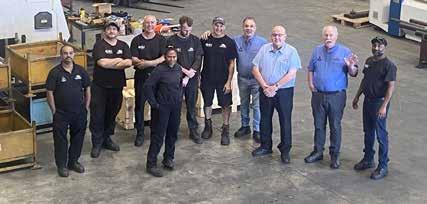
HC-ATM – Competing with imports on price and quality
Brisbane-based manufacturer HC-ATM Group prides itself on manufacturing high-quality truck, trailer and tooling aftermarket parts for the heavy transport industry. Trading under the name of Australian Truck & Trailer Parts, it is regarded as an essential supplier to Australian distributors and major transport brands, and has experienced an increase in demand for its products during COVID lockdowns. Directors Peter Henderson and Greg Hudson first acquired the business’ assets in 2010 from a Brisbane manufacturer that was closing. Both Henderson and Hudson had worked together in IT, before creating Australian Tool Manufacturers, as the business was known then. Henderson and Hudson are still the majority investors in the business, and together with Murray Curti running daily operations, they form a team that has been able to implement advanced manufacturing concepts with their key staff. The wide range of products made in their factory can compete with imports both on price and quality. Henderson says that when Curti came onboard, it was to help them develop and streamline the manufacturing design and operations side of the business: “Murray, who’s our Operations Director, is a trade-qualified boiler-maker and certified welder, and he’s very talented in finding alternative, cost-saving solutions to manufacture and solve existing problems with OEM parts.” Curti adds: “My previous working history required me to go into companies to problem-solve and implement solutions to existing problems. When I came onboard at HC-ATM, we invested in advanced manufacturing technology and machinery, which we continue to do today and for the foreseeable future.” “We are a problem-solving manufacturing company, number one,” says Henderson. “Murray is contacted daily by transport operators, so he goes out to help them with suspensions and other components. He offers a solution to their problems, then comes back to redesign it in-house, and then manufactures a prototype for trial. We sell worldwide and are very competitive in price, against the imported variants coming in from Europe, China and elsewhere, as many of parts don’t stand up to the Australian conditions and roads.” Speaking on one issue that they solved recently for an international truck manufacturer, Curti explains: “When their V8 trucks were pulling heavy loads up the hills, they had a lot of problems with the manifold cracking. The manifold is an important keg in the truck’s exhaust system. Every six months they had a costly manifold replacement, plus the trucks were off the road, being repaired. “The manifold was cracking because of casting limitations, so we redesigned and machined a new manifold that takes away any limitations that manufacturing previously had, by making it from a billet of steel on our Okuma five-axis machine. The transport company is very happy, as the manifold we have made for their trucks will last for many years to come. There is now a high interest in this manifold and the potential to make other manifolds for different brands and purposes in other industries.” HC-ATM has conducted a lot of R&D and one area of focus is in the redesign of rubber engine mount suspension systems for its customers. “We were contacted by a large cleaning and rubbish removal contractor that had started buying their trucks from an international truck manufacturer,” says Curti. “The two original rubber engine mounts that were supplied in those trucks became faulty quickly. The cleaning contractor sent the truck manufacturer to us to solve the problem. They were using a rubber engine mount on the engine, which is not suitable for Australia’s climate. I redesigned it using a strong polyurethane polymer instead of rubber – it’s been a great success for all concerned. Business is good HC-ATM at the moment. Currently the company is struggling to keep up with the demand for its products and services. It will be increasing employee numbers from its existing team of 16 people in the near future. “Our biggest problem is securing our raw advanced material, most of which comes from Europe, so there are delays on the docks, because of COVID restrictions,” adds Henderson. “However, COVID has been very good for our business as a lot more clients are now buying our Australian-made components, because of the delays in getting imported parts into this country. So that’s a positive for our company and for Australian-made.”
www.alstom.com www.hofmannengineering.com www.aussietruckparts.com.au












